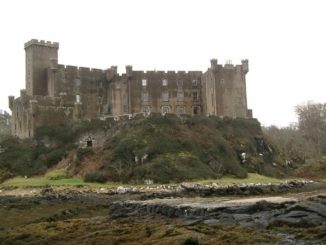Hello again Puffins.
I’ve been pretty snowed under for the last few months with Property Management problems and having been on one of my caravan expeditions for the last few weeks.
MY CURRENT LAND-VOYAGE BY CAR, CARAVAN and FOLDING E-BIKE
The Kennet and Avon Canal
I stayed first between Devizes and Melksham alongside the Canal and made a few rides along its towpath in both directions. One of them saw me ascending the 2 mile long Caen Hill and its 29 locks. The difference in water level between the highest and lowest is 237 feet and there are 16 of them just a few barge-lengths apart, one after the other, at the steepest section.
Here is a photo I took when stopping half way up to recover my breath, slow my fast-beating heart and rest my weary legs (gulp-gulp).
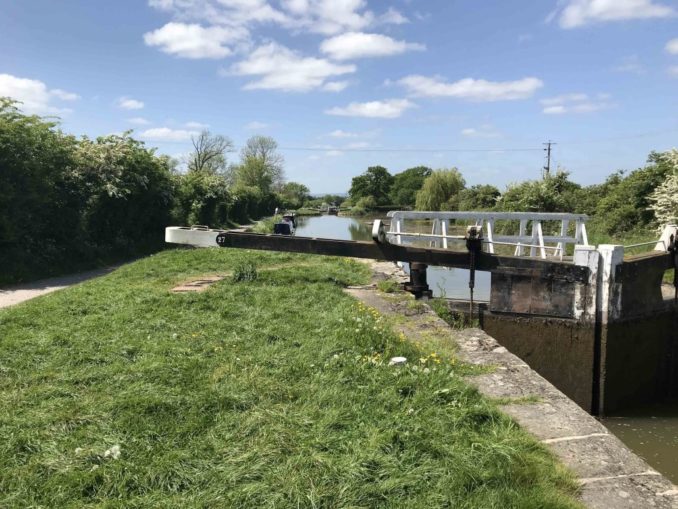
The idea of linking the ports of London and Bristol with a navigable waterway by building a canal between the two rivers was first conceived in Elizabethan times but a combination of Landowner and Commercial vested interests delayed the start of work for about 200 years until the end of the 18th Century. Construction was finally begun in 1796 and finished in 1810 (a similar period to the construction of Nuclear Power Stations these days but for different reasons).
That was a shorter period between concept and completion than for many other famous canals.
For example, Emperor Augustus conceived the idea of building a waterway between the Mediterranean and the Atlantic around 0 BC but the Canal du Midi completing one physically wasn’t finished until 1681! In addition to vested interests (which I don’t suppose bothered Augustus very much) the main physical problem in all such cases was the difficulty of finding a sufficiently reliable water supply as a great quantity escaped to sea each time a lock was used.
Supply for the Kennet and Avon was eventually found near Crofton about 20 miles away on the North Wessex Hills near Marlborough. It’s altitude was about 40 feet lower than the high point of the final route though, so channels had to be built and Beam Engines installed to get it to the point at which it was needed. These days, water is conserved by pumping it with modern equipment from the bottom of Caen Hill back up to the top (when there’s enough electricity to operate the pumps, which there usually has been until recently, but I guess continuous use is now under threat of being interrupted) .
The canal was privately financed and its unclear whether the original Investors got all their money back. It was profitable to begin with because the owners could offer faster transport at lower rates for transfer of bulk goods (mainly coal and stone) than those charged for movement of the same volumes by the poor roads of the time. (Opposition from road hauliers to the canal’s construction was one reason it was delayed for so long. Some things never change do they? Witness arguments and delays to the extension of Heathrow Airport and the High Speed rail link to the north. Only Historians can opine who was right and who wrong. Their conclusions are only opinions too. We can’t turn time back and see what the result would have been if different decisions had been taken. So it will be about modern disagreements as well as historical ones.)
A few years later Stephenson invented a coal-fired steam engine that drew a train of coal-trucks along rails between Stockton and Darlington in County Durham. The idea caught on and the Great Western Railway was built providing transport between Bristol and London that was even cheaper and faster. GWR took-over the Canal in 1852, put up the prices for using it and spent less on maintenance. As a result, traffic was transferred to their trains and the canal started losing money and came under threat of closure. Corporate behaviour hasn’t changed much either, has it? The canal limped on for the next 100 years or so, falling into an ever-increasing state of disrepair.
I know it did because my father and I tried to canoe along it circa 1949 in company with the Assistant Scout Master of a Troop I had joined and another boy. We had to give up around Hungerford and put the canoes on a train to Reading in order to complete our plan to reach Maida Vale near Paddington Station via the Thames and the Grand Union Canal that we entered through the locks at Brentford.
A group of enthusiasts got together a few years later and sent a petition in 1956 to the recently crowned Queen Elizabeth II seeking her support to prevent the canal being closed altogether. That worked eventually, and The Kennet and Avon Canal Trust was set up and funded in 1962. Nowadays the canal has been cleared for its full length and the locks have been restored. The canal is no longer an eyesore but attractive instead because of the wildlife it supports, its historical interest and its recreational popularity. Here are a couple of photos illustrating the last point.
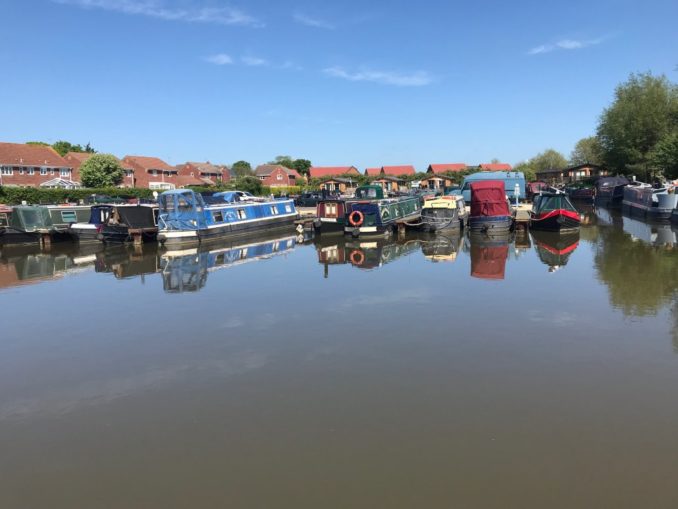
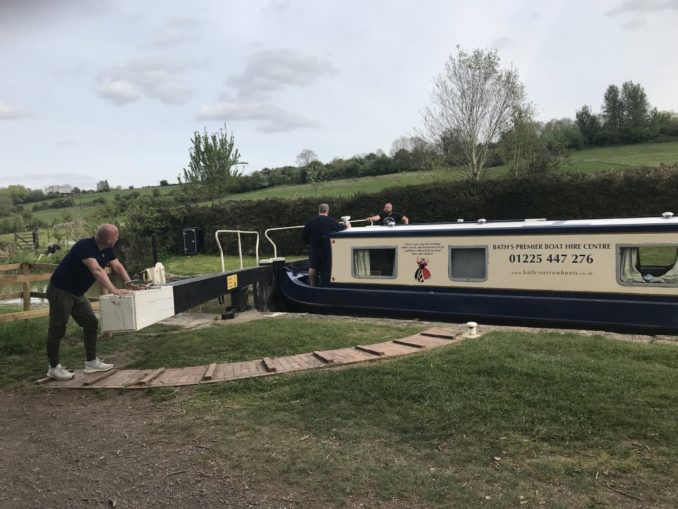
The second pic shows going through the locks is a lot simpler than doing the equivalent on the Panama Canal which I traversed twice in Alchemi and twice as a crew member on other yachts. But then, this one was built 100 years earlier.
By the way, water supply in Panama was not a problem because the Gatun lakes hold a huge volume frequently replenished by tropical rainfall. The main problems there were tropical diseases and the need to cut a deep channel through the narrow but high range of hills forming the country’s backbone – thousands died during its construction.
In Wiltshire recently I enquired about how Caen Hill got its name. No one seemed to know so I tried to find out from sources on the internet. I got as far as learning that Caen in France was a major Norman city in William the Conquerors day and a bastard grandson named Robert de Caen was appointed the first Earl of Gloucester by his father, King Henry I of England, in 1121 or 1122. Robert owned land and castles in many places in both England and Normandy and I thought the Hill at Devizes might have been named after him.
I discussed this with my daughter in Australia during one of our FaceTime chats and she promptly came up with a rival explanation from another source. No, Caen Hill was named much earlier after a Saxon tribe called Canning also known as the “People of Cana” . I have since found several other explanations of the name “Canning” given to both people and places, often with another title attached. Bishops Canning, very close to Devizes is one such, but other sources say that’s not surprising because they attribute the name’s origin to the ecclesiastical office of Canon.
Our problem is that different sources are adamant their explanation is the true one. We would appreciate confirmation, correction or replacement of either theory by any Puffin with more authentic sources than the ones we found.
Exmoor and the North Devon Coast
I have since moved on and am writing my first draft for this article at a site on the coastal edge of Exmoor near Lynton about 800 feet above sea level with the water at the bottom of a steep cliff a mile or so to the west. There are views across the Bristol Channel to Swansea and the rest of the Welsh coast when the weather is clear.
There is roughly 2, 000 miles of open ocean between here and Newfoundland. The wind across it picks up a lot of water much of which it dumps on Exmoor as soon as it arrives. It’s raining now and blowing half a gale.
Fortunately the Devonian Rocks here are sufficiently old and stable not to move so much as the sea did in similar conditions when I was sailing.
Exmoor is one of the National Parks so its very difficult to get permission to construct new buildings or to change existing ones. Much of the land is farmed but without employing many people. Many of those who live here use their properties to provide services to tourists and the roads are notorious for their narrow and winding nature with high banks and hedgerows on either side.
I had relatively little difficulty in towing my caravan here in May without generating long queues of traffic behind me and the villages and landscapes are very attractive as I hope these photos will show.
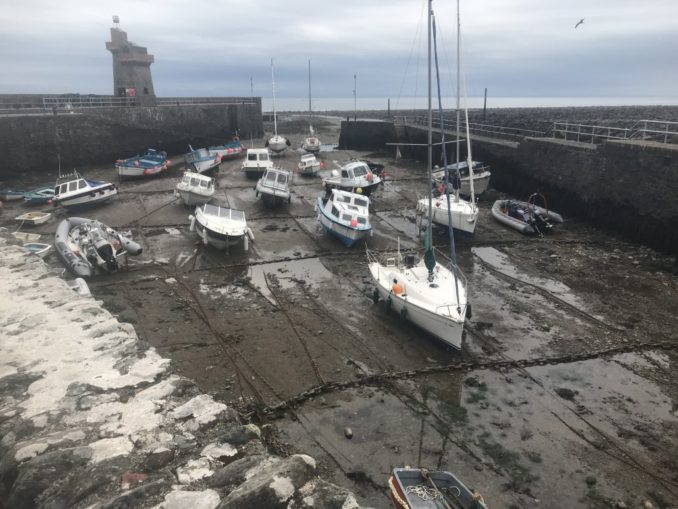
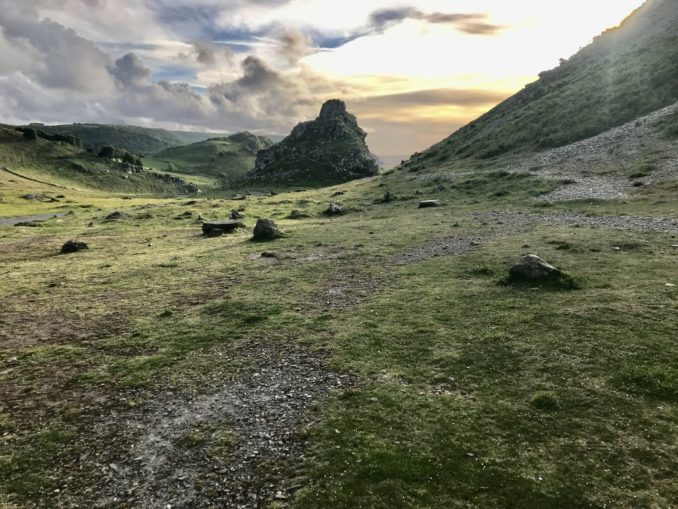
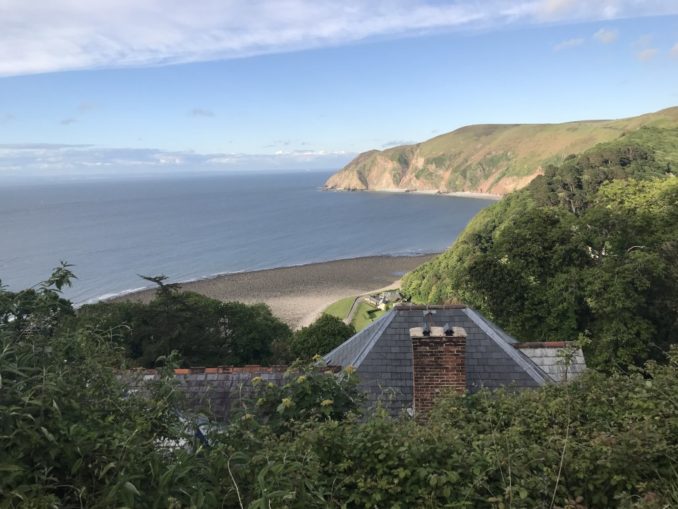

Another day I made an expedition to Dunkery Beacon which is the highest point on Exmoor about 1,700 feet above sea level.
Here are three pics I took that day illustrating that I did get to the top with a bit of a struggle on a beautiful day with a clear sky showing it doesn’t rain continuously in the West Country. That was the first time I had done so for 75 years when my father and I cycled down here, staying at Youth Hostels on the way (thank you Dad, you were a good father).
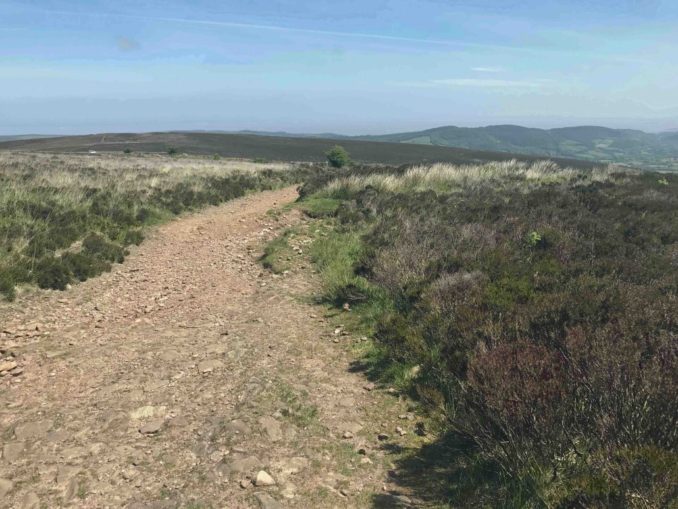
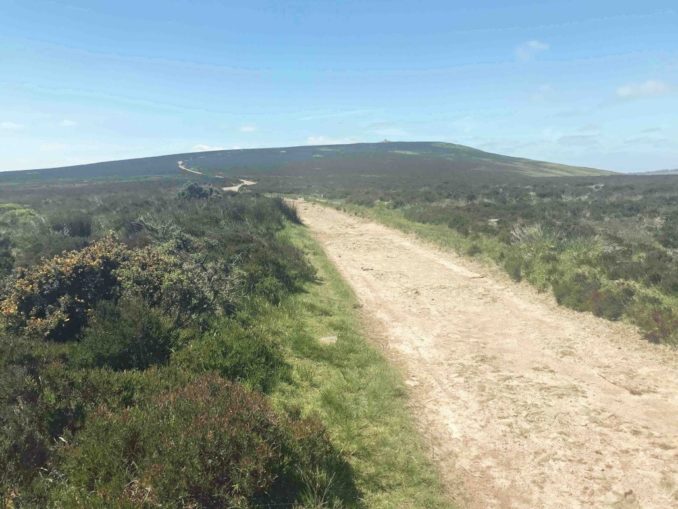
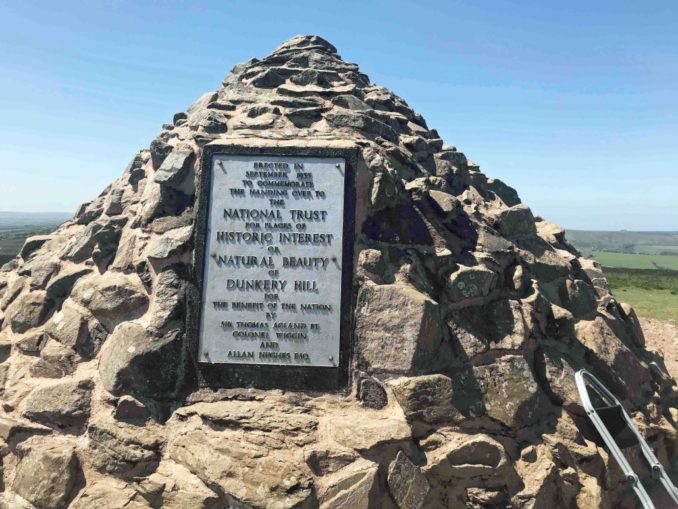
OCEAN CURRENTS AND THE EFFECTS OF THE EARTH’S SPIN
Here is another copy of the chart from Wikipedia I included in Part 1 of this second series of SMLA showing the major currents in the World’s oceans.
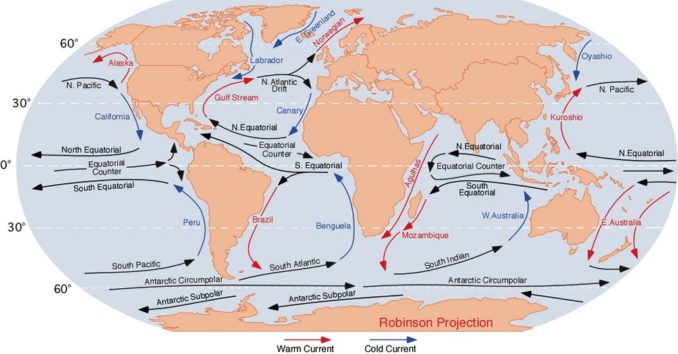
That excited considerable discussion in the comments no one reads with Mrs Raft’s being particularly pleasing. She was so interested she experimented with an orange and a skewer in her kitchen but couldn’t figure out why they circulated in different directions in the northern and southern hemispheres. In the end she abandoned her efforts and sensibly ate the orange saying to herself – “no doubt some Puffin will be able to explain it.
I haven’t noticed anyone doing that and have decided to have a go myself.
Please stick with me because I’m going to attempt it in a way that eschews the details I studied 65 years ago during the first year of my Maths undergraduate course, and the way it is explained by modern experts who write scientific treatises and articles in Wikipedia.
I think its important you should grasp the concepts, because the phenomenon underpins modern attempts to create numerical models of the earth’s climate and through those influence the current political drive to achieve Net Zero by 2050, the plans to abandon the use of petrol and diesel cars and so forth.
My starting point is to take you right back to your school days. I’m sure you’ll remember the story of how Isaac Newton was inspired by the apple falling on his head to suggest all objects are attracted to one another by the force of gravity. He also went on to evolve his three famous laws of motion,the first two of which may be summarised as:
A body in motion continues in a straight line at constant speed unless acted upon by a force
When a force is applied the rate of change of its momentum with time equals the force. (sometimes expressed more succinctly as mass x acceleration = force)
Apparently simple concepts that have profound consequences.
Going back to school again you may remember playing on a roundabout in the grounds or a local park. Do you recall that you tended to be flung off with apparently greater force the faster it went?
That only happened when the roundabout was spinning and you were standing on it at some point distant from its centre. You didn’t feel the same force if you stood in the exact centre, nor if the roundabout was stationary. Neither did a nearby friend, parent or teacher when it was. What was going on?
Evidently, the feeling was due to the spin of the roundabout. The scientific explanation is that even though you were stationary on the roundabout you were constantly changing your position and direction of movement in space, thus experiencing an acceleration and an apparent force in accordance with Newton’s law. This phenomenon became known as a Centrifugal Force.
The same effect happens when you are standing on the surface of the earth which can be assumed to be spherical for the purposes of this explanation and to have no atmosphere and no oceans.
Figure 1 shows the effect acting on a body stationary on the surface at Latitude L that is also subject to the force of Gravity. The figure also has a small triangle in the bottom right hand corner showing that the mathematical functions sin and cosin merely define the length of the shorter sides of a right angled triangle as a proportion of the length of its longest side.
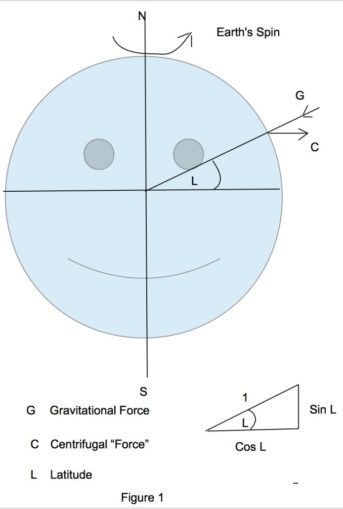
As an aside, I note that keen weight watchers might want to take advantage of the centrifugal force on earth since it is at a maximum at the highest hill they can find on the equator. If a typical man weighed himself there he would find he was about 1/2 lb less than if he did the same at the north or south pole, or maybe a bit less still if he’d perspired a lot climbing to the top of the hill. Delicacy inhibits me from saying what advantage ladies might obtain.
Newton and his contemporaries understood and worked upon these concepts, including the next step of resolving the Centrifugal Force into two components, using the ratios sin and cos to get the right proportions. One component would act radially outwards and the other tangentially to the surface along a meridian, as shown in Figure 2.
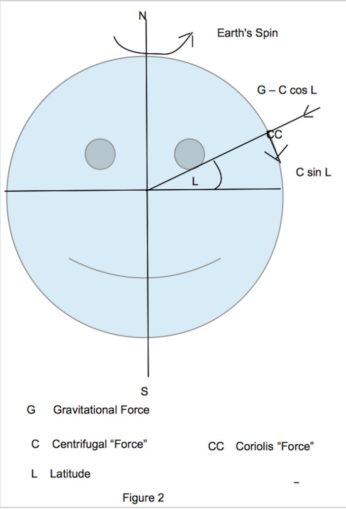
Now you begin to get a hint of one factor causing different behaviour in the two hemispheres because you’ll note the latitudinal component of the centrifugal force is directed towards the equator. If an object is free to move relative to the surface it will do so in a southerly direction in the northern half of the globe and a northerly one in the southern half.
That’s not the end of the story though because you’ll see the letters CC depicting the position of an object that’s free to move about on the surface or even to leave it upwards at an angle from the tangential plane. You’ll also see the words “Coriolis Force” against them in the key at the bottom.
Gaspard-Gustave Coriolis was a French Mathematician studying the dynamics of watermills in early 19th Century France who looked into the way in which an object in motion would behave when launched from a spinning spherical component but free to move relative to it.
He deduced the existence of another acceleration in such systems giving rise to another apparent force, rather similar to the centrifugal one, but acting in a direction at right angles to both the spin axis and to the direction of movement of the body.
Artillery officers were amongst the first people to use this discovery when aligning their guns. They did so as early as 1851 when they observed a shell shot due north of their own position when fired was no longer due north of them when it landed. It arrived a little farther East than they expected. I have no direct experience but I believe modern snipers allow for the same effect when taking aim – perhaps Blown Periphery can confirm that.
M. Coriolis’s mathematical deductions explained why that happened, and was an important step on the way to people realising Newton’s laws were a fantastic advance on what had gone before but formulae derived from them needed a small adjustment to bring the result into closer correlation with what could be repeatedly observed in practice.
Albert Einstein, followed by others, took an even larger step less than 100 years later when he and they realised further small adjustments could make the predictabilty of future events even more accurate. Einstein’s theories were described as being those of the General and Special Theories of Relativity because they were founded un a recognition that our perception of movement and time comes from one phenomenon being described in terms of its position relative to something else, and not to an absolute position in either time or space.
We don’t need to follow Einstein though to appreciate the consequences of M. Coriolis’s discovery of the acceleration named after him.
It didn’t take long after his 1835 publication and Artillery Officers’ application of it to make gunfire hit its target more frequently, before people interested in weather behaviour thought – “Hey! We could use this by imagining a chunk of the atmosphere to be an object free to move relative to the surface of the earth” and applying M Coriolis formulae to see how it will behave.
Thus began a change to weather and climate prediction methods that have continued to this day leading to things like the the plan to ban the sale of petrol and diesel cars, and other matters every-one will be familiar with. The same sort of thing happened in other fields and the one that inspired this article was the application to oceanography including the behaviour of the major ocean currents.
It is hard to provide a deeper explanation of why currents circulate in different directions on either side of the equator without going into the detailed mathematics and that’s why Mrs Raft couldn’t find an explanation by twiddling an orange on a skewer. She deserves 10/10 for being sufficiently curious to try though. That is the spirit and driving force of a true scientist as distinct from the faux ones dependent for their livelihoods on financial support from people with different motives altogether.
Let me also remark the Coriolis “force” is weaker than the centrifugal one unless the object is moving very fast indeed (as an artillery shell or a sniper’s bullet do). You also know from my weight-watcher example that the centrifugal force is pretty small itself. These forces, arising from the mass of a body – gravity, centrifugal and coriolis – are often called inertial ones because their magnitude is directly proportional to the mass of the object upon which they act and the product of mass and velocity, called momentum or inertia. That’s why we say in ordinary speech that an object has a lot of inertia if it takes a large force to get it moving, or a lot of momentum if its already in motion and we want to change its direction, or stop it altogether.
Other types of force are often created by temperature differences. Low ones near the poles, high ones near the equator, colder at night than in the day, in winter rather than summer, if the sky is clear or cloudy, and so on. These temperature differences, arising from the changing intensity of the sun’s radiation and the topographical features of the surface often create stronger forces than inertial ones created by the earth’s spin. They too have a profound effect on movement in the oceans and the atmosphere. and are important drivers of phenomena like the Gulf Stream and the Benguela Current.
The presence and shape of land masses also have a critically important effect on oceanic and atmospheric behaviour through the resistance to movement at their physical boundaries and the different speeds at which water and land change temperature. Prediction of climate, weather and oceanic behaviour is made more difficult still because they interact with one another. Water temperature is slower to respond to changes in radiation than air; winds are created by pressure differences between one place and another and those are due mainly to temperature differences which are themselves induced by the passage of air over water, as well as by radiation; air can blow water about creating waves and currents, especially if it keeps blowing for a long time in the same direction, as the Trade Winds do, and the Westerly Winds of the Northern and Southern Oceans. All these effects influence the strength and direction of ocean currents as well as those due to inertial forces.
In considering all these matters its important to remember – “Many a Beautiful Theory has been destroyed by an Ugly Fact”. Genuine Scientists modify or discard theories that are not supported by objective and careful observations. False scientists, whose livelihood depends on the generosity or gullibility of others don’t do that. They have a vested interest in their audience believing what they are told. They are more like the Priests of Ancient Egypt using prestige and mystique to gain a special position in human society. Sometimes its hard to tell who are genuine and who are false because the latter are often masters of the specialist language developed by the former. Some-one once said about politicians – “Judge them by what they do and not by what they say!”. I think Scientists should similarly be judged by – “The degree to which observations accord with their predictions”.
Problems arise of course when politicians want to do something to increase their control or popularity and introduce laws based on unproven scientific theories without waiting to learn whether observations do accord with predictions. They always claim “It is for the Public Good” and sometimes it is. But sometimes the laws they introduce have a directly opposite result. It remains to be seen which turns out to be nearer the truth over their creation of a Health Crisis to deal with a virus of the common cold type, an Economic one by Printing Money to cure an Excessive Debt problem, an Energy Crisis to prevent Climate Change and a Military one over the war in Ukraine. But, this is intended to be an escapist article that also tries to explain complex science using ordinary language so I’ll revert to Sir Isaac and Gaspard-Gustave.
There is a formidable volume of evidence that ocean currents do flow in the directions shown on the Wikipedia Map and I have personally experienced two fast flowing warm currents and one cold one when sailing in Alchemi – The northward Gulf Stream between Cuba and Mexico and up the the coast of the USA, the southerly Aghulas current off the east coast of Africa and the northerly Benguela current off its West Coast. I have also experienced the slower ones of the equatorial and south equatorial currents.
Those experiences and less anecdotal data have convinced me that the theories propounded by Newton and Coriolis go a long way to describing why Ocean Currents are generally clockwise in the north and anti-clockwise in the south. Inertial forces are also believed to be a significant factor in the formation of Hurricanes and Cyclones. It’s small wonder though that an orange and a skewer didn’t help explain an understanding of what causes them.
Amongst other interesting observations it has also been noticed that flies and some moths have developed specialised sensors and other organs that measure the effect of the Coriolis Force on their flights, and adjust their movements accordingly!
Ain’t maths, science and the real world interesting?
I hope next time to get back to telling you more about my first experience of ocean sailing and the Azores Islands.
To be continued …….
© Ancient Mariner 2022


